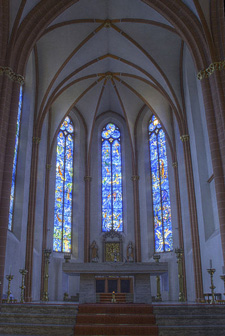|
Marc Chagall was undoubtedly an artistic genius who dabbled in almost every art medium, from fine art prints, to tapestries, book illustrations, ceramics, paintings, stage sets, and, later on in his career, stained glass windows.
Chagall windows are well-known for their vibrant colors and their stunning beauty. His first foray into stained glass work was in 1960 when he started a series of 12 windows for the synagogue at the Hadassah-Hebrew Medical Centre in Jerusalem. The twelve window panes took two years to complete. His inspiration was drawn from The Bible, more specifically, from Jacob’s blessing of his 12 sons and Moses’ blessing of the 12 tribes. Each breath-taking window consists of one dominant color and a quotation from each blessing.
Charles Marq, an assistant to Chagall at the time, implemented a special process of applying color to glass. This innovative procedure permitted Chagall to use as many as three colors on one pane, instead of having to separate each color with a lead strip, which was the traditional method used in stained glass creation at the time.
Chagall Windows in All Saints Church
Another spectacular series of 12 Chagall windows can be seen at All Saints
Church in Tudeley, a hamlet in England. They are a tribute to Sarah D'Avigdor-Goldsmid,
the late daughter of Sir Henry and Lady D'Avigdor-Goldsmid. Sarah was killed
in 1963, at the age of 21, in a tragic boating accident.
After Sarah’s untimely death, her parents commissioned Chagall to begin work on memorial stained glass windows, for Sarah had so admired those she had seen during her visit to the Louvre with her mother in 1961. The first memorial window was installed in 1967. The remaining windows were designed over the following 15 years, again with the help of Charles Marq.
Chagall in the Lobby
In 1964, an impressive stained glass Chagall window was installed in the lobby
of the United Nations building, a gift from the U.N and from Marc Chagall
himself. It is a memorial tribute to Dag Hammarskjold, the second secretary
of the United Nations. Hammarskjold, along with 15 others, was killed in a
tragic plane crash in 1961. The Chagall window depicts symbols of peace and
love, a young child being kissed by an angel, and vibrant masses of flowers.
The electric blue background displays a musical symbol, which is said to represent
Beethoven’s Ninth Symphony, one of Hammarskjold’s favourite classical
pieces.
